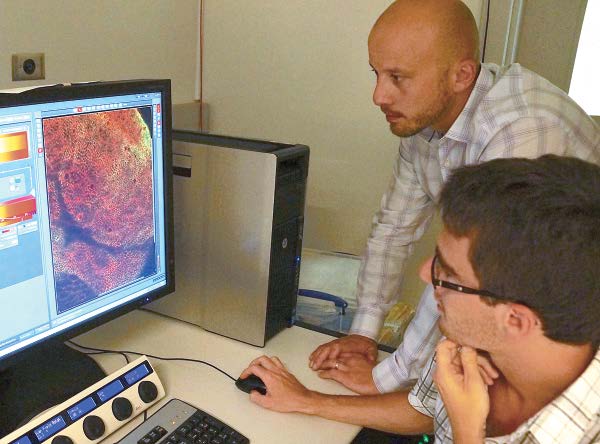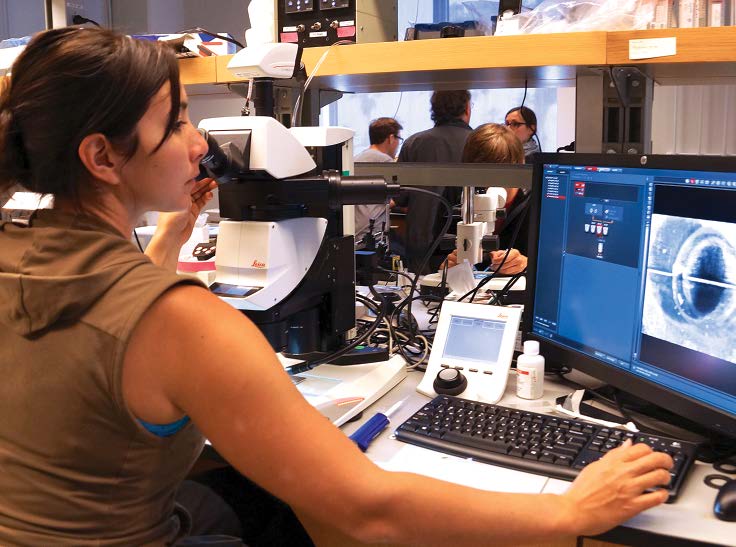 Nicolas Loyer, a French Ph.D. student (seated), and Leica technical representative, Olivier Brun, look at an image of a fruit fly wing disc. Photo by George Foulsham.
Nicolas Loyer, a French Ph.D. student (seated), and Leica technical representative, Olivier Brun, look at an image of a fruit fly wing disc. Photo by George Foulsham.
It’s a summer course like no other at UC Santa Barbara or anywhere else. Spread between the lecture halls of the campus’ Kavli Institute for Theoretical Physics (KITP) and labs in the California NanoSystems Institute (CNSI), the Santa Barbara Advanced School of Quantitative Biology was abuzz with activity in 2013. Here, participants from around the world — graduate students, postdoctoral fellows and even science faculty members — rub shoulders with leading experts in the field and shed new light on the dynamics of morphogenesis. Morphogenesis is the process that converts the genetic blueprint of a multicellular organism into complex physical structure.
“This program is really unique in that it’s incredibly interdisciplinary,” said Michelle Dickinson, a senior lecturer (assistant professor) at the University of Auckland and a student in the course. “It’s physics combined with biology, and technically I’m an engineer so it combines engineering, too. It’s a great place to meet world leaders and experts, and live and eat and breathe the science that we’re trying to solve.”
The course, “New Approaches to Morphogenesis: Live Imaging and Quantitative Modeling,” presented by KITP and CNSI, brings together close to 100 international scientists from various fields to collaborate on the problem of animal development. “Quantitative biology is really a major construction project in science and so is a very natural focus for an interdisciplinary school,” said Boris Shraiman, Susan F. Gurley Professor of Theoretical Physics and Biology, permanent member of KITP and a founding co-director of the course. “Our special take on quantitative biology is to bring theoretical modeling together with experiments and integrate it and make it part and parcel of the biological method.”
Years in the making, the course is designed to advance late Scottish biologist and mathematician D’Arcy Thompson’s agenda of quantitative description outlined in his 1917 book, “On Growth and Form.” But almost a century later, these scientists are using the full power of modern imaging and molecular genetics, which makes the field ready for rapid progress. “We designed it in such a way that these experiments would be open-ended,” noted Shraiman. “We hope new collaborations will form and the work started here will continue.”
 Michelle Dickinson, a senior lecturer at the University of Auckland, works on C. elegans’ early embryonic development. Photo by George Foulsham.
Michelle Dickinson, a senior lecturer at the University of Auckland, works on C. elegans’ early embryonic development. Photo by George Foulsham.
On the technical level, the course introduces several model organisms, including fruit flies, roundworms and sea squirts, and provides instruction on live imaging, micro-manipulation and genetic and chemical perturbations as quantitative tools to study developmental dynamics.
“We were able to draw on the research strength of our faculty colleagues on campus, several of whom —Denise Montell and Bill Smith from the Department of Molecular, Cellular and Developmental Biology and mechanical engineering professor Otger Càmpas — are engaged in running experimental projects,” said Shraiman.
The morphogenesis course also got outside help from such experts as Thomas Lecuit, a group leader at the Developmental Biology Institute of Marseilles. In his UCSB project, students built a single-plane illumination microscope (SPIM) and then used it for imaging rapid developmental processes taking place in fruit flies and sea squirts.
Another project, led by Thomas Gregor, an assistant professor of physics at Princeton University, examined with near molecular precision the spatiotemporal dynamics of gene expression in the fly embryo. Other projects focused on spatial arrangement and rearrangement of cells in developing tissues and on temporal fluctuations and oscillations that control cell differentiation and tissue patterning.
“What’s clear is they’ve got the right people, people with expertise from all over,” said Seth Donoughe, a Harvard graduate student who worked on the SPIM project. “My fellow students have tons of experience, lots of expertise in different areas. In terms of getting exposure to scientific stuff that people are doing and thinking, it couldn’t be better.”
- Julie Cohen, UCSB Public Affairs & Communication
KITP Newsletter, Winter 2015
